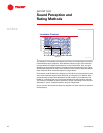
14 TRG-TRC007-EN
notes
period one
Fundamentals of Sound
Again, these reference values can be considered the threshold of hearing. The
multiplier 20 is used in the sound-pressure level equation instead of 10 because
sound power is proportional to the square of sound pressure.
Measuring sound using a logarithmic scale means that decibel values cannot
be added arithmetically. Instead, logarithmic addition must be used to add two
or more sound levels. This involves converting the decibel values into ratios of
sound intensity, adding these ratios, and then converting the sum back into
decibels. The mathematics become rather involved—the graph in Figure 17 has
been developed to simplify the procedure.
To demonstrate the use of this figure, consider the example of adding a 50 dB
sound to a 44 dB sound. The difference between these two sounds is 6 dB.
Therefore, 1 dB is added to the higher of the two sounds (50 plus 1) to arrive
at the logarithmic sum of 51 dB.
Also, notice that the logarithmic sum of two sounds of equal magnitude (0 dB
difference) results in a 3 dB increase. Therefore, adding two 50 dB sounds
would result in a combined sound level of 53 dB.
L
p
20 log
10
sound pressure, µPa
20 Pa
--------------------------------------------------------- -
or 10 log
10
sound pressure, µPa
20 Pa
--------------------------------------------------------- -
2
=
Logarithmic Addition of Decibels
0
0
5
5
10
10
15
15
3
3
2
2
1
1
0
0
dB difference between values being added
dB difference between values being added
add to the higher dB value
add to the higher dB value
50 dB + 44 dB = 51 dB
4
4
5
5
Figure 17


















